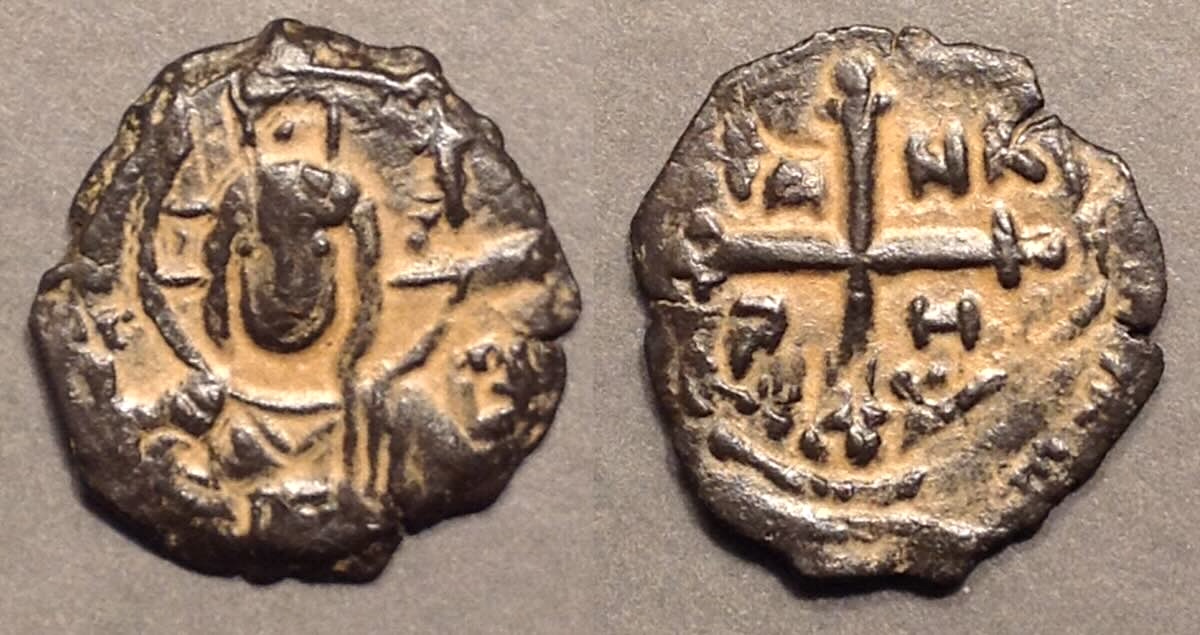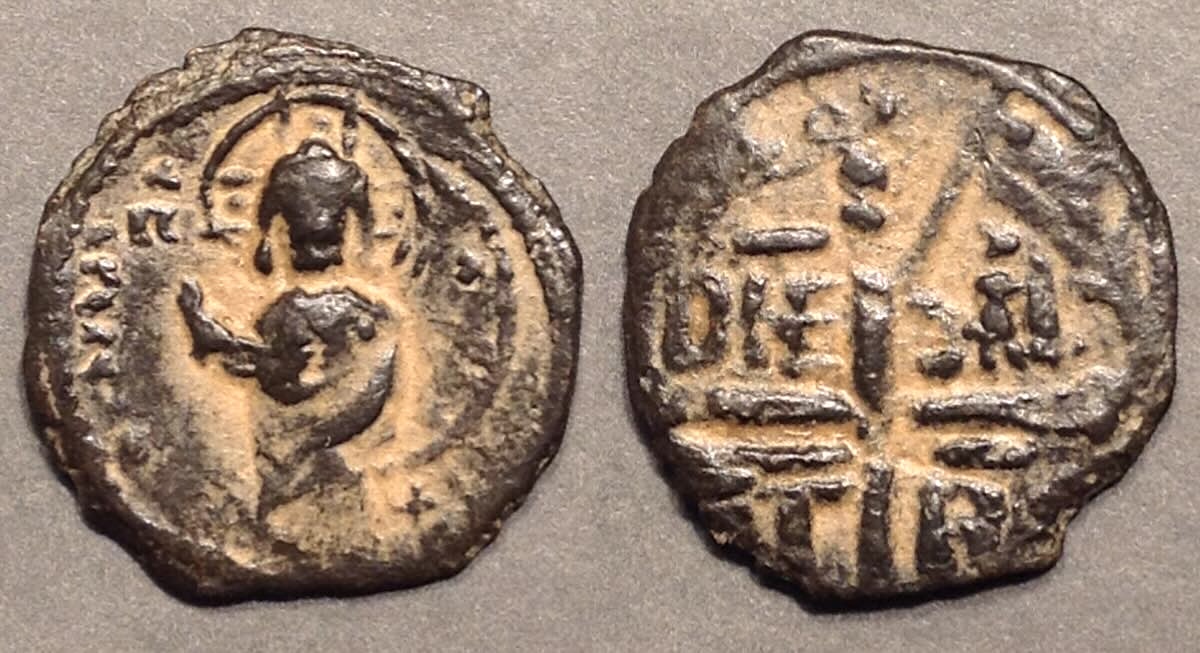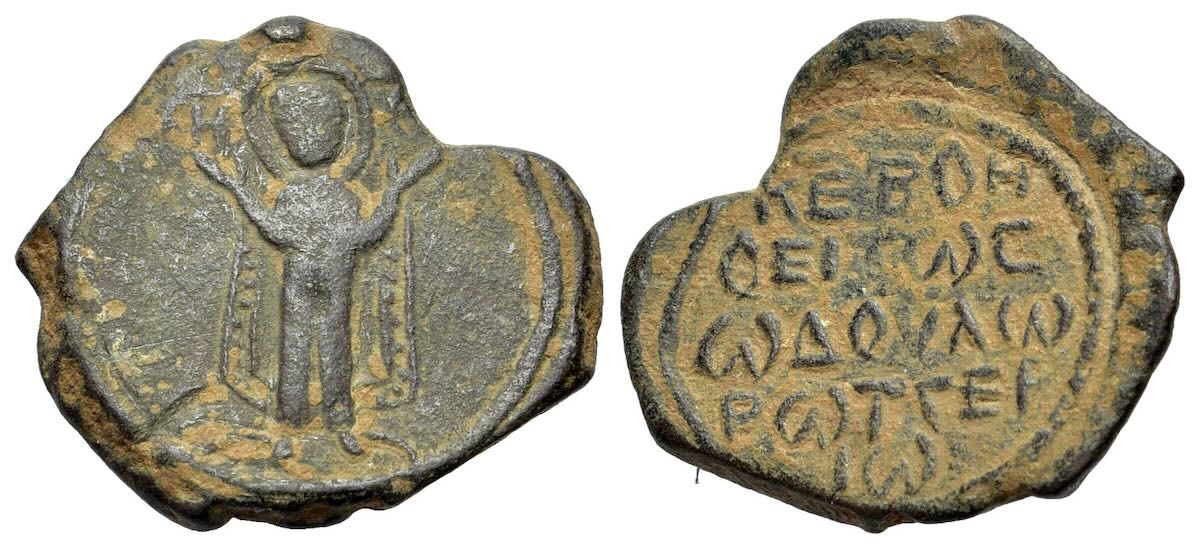(Click the thumbnail for a larger image and ID
and then click that larger image for the history)









Coins of the First Crusade
After the thumbnails, this page lists the coin types from the First Crusade in two tables--one table for types from Antioch and the other for types from Edessa.
The main page merges the coins and the history.
Antioch. (Skip down to types of Edessa.) Coins from Antioch are much more common than coins from Edessa.
| ID number and size in mm Image (image sizes are proportional) (Click on the image to go to the main page discussion of it.) Description |
Ruler Dates |
References CCS pages 198-201 Metcalf pages 25-28 and plates 3-6. |
CCS Antioch 1. c. 25 mm. Bust of St. Peter facing Cross with B H M T in the angles |
Bohemond I 1098-1101, 1103-1104 |
CCS 1 Metcalf Type 1, coins 47-48 Image courtesy of PC1 |
| CCS Antioch 2. Bust of St. Peter facing/ 4-line legend (Unique, and possibly not crusader) |
Bohemond I? (Maybe not) |
CCS 2 Metcalf Type 2. "unique. Possibly, however, Italian" Porteous 15. |
CCS Antioch 3. c. 23 mm.  Bust of St. Peter facing, long cross over his left shoulder 4-line legend: +KEBOI/θHTOΔY/ΛOCΩVT/ANHPI |
Tancred 1101-1103, 1104-1112 |
CCS 3, the first type (of four) for Tancred. (3a is normal size, 3b is for a few that are smaller, 17 mm or less) Metcalf Type 3, coins 49-62 (61-62 are the smaller size) Image courtesy of PC1 |
CCS Antioch 4. c. 20 mm. Bust of Tancred facing Large square cross with IC XC NI KA in the angles. |
Tancred 1101-1103, 1104-1112 |
CCS 4, the second type (of four) for Tancred. (4a is normal size, 4b is a bit smaller, 18 mm or less) Metcalf Type 4, coins 63-70. (There is no obvious size distinction.) Image courtesy of PC1 |
CCS Antioch 5. c. 21 mm.  Bust of Christ facing Large square cross with TA NK P H (for "Tancred") in the angles |
Tancred 1101-1103, 1104-1112 |
CCS 5, the third type (of four) for Tancred. Metcalf Type 6, coins 81-83 (84-85 are the same type, but not illustrated) Note: CCS and Metcalf reverse the orders of their types 5 and 6. Image courtesy of PC1 |
CCS Antioch 6. c. 22 mm.  St. Peter standing, r. hand blessing, left holding long cross Large square cross with D S F T in the angles. (for "Domine Salvum Fac Tancredum" "Lord, save Tancred") |
Tancred 1101-1103, 1104-1112 |
CCS 6, the fourth type (of four) for Tancred. Metcalf Type 5, coins 71-80 Note: CCS and Metcalf reverse the orders of their types 5 and 6. CCS says 6 is "often found overstruck on Type 5". Metcalf says [p. 27] the reverse--that Type 5 is overstruck on Type 6. (It can be very hard to tell which is the overtype. See here for an example.) Image courtesy of PC1 |
CCS Antioch 7. c. 21 mm.  Christ standing facing, raising right hand in benediction (The second example is different.) Cross with DNE SAL (NE ligate) IT RO in angles (for DomiNE SALvum Fac Tuum ROgerium "Lord, save your Roger") |
Roger of Salerno 1112-1119 |
CCS 7, the first type (of three) for Roger. Metcalf Type 7, coins 86-88 Images courtesy of PC1 |
CCS Antioch 8. c. 23 mm - 21 mm.   Virgin standing orans, MH ΘV either side / 5-line legend: "Lord, help your servant Roger" KЄBOH ΘЄITωC ωΔOVΛω POTSЄP [The rho begins the name of Roger. We use "G" where the coin has "TS". Different legend breaks are common.] Iω |
Roger of Salerno 1112-1119 |
CCS 8, the second type (of three) for Roger. Metcalf Type 8, coins 89-94 They agree it is overstruck on Type 7 Images courtesy of PC1 |
CCS Antioch 9. c. 20 mm.  Horseman (St. George) riding right spearing small serpent (dragon). Three line legend beginning POT3ЄP, for Roger. |
Roger of Salerno 1112-1119 |
CCS 9 "Overstruck on the previous two types of Roger." The third type (of three) for Roger. Metcalf Type 9, coins 95-101. Overstruck on CCS 8. Note: The flan is usually slightly too small for the dies. Image courtesy of PC1 |
CCS Antioch 10. c. 20 mm.  Bust of St. Peter, holding long cross over his left shoulder Cross, with BA IM ɣN ΔOC in the angles |
Bohemond II, 1126-1130 | CCS 10, The only type for Bohemond II (10a supposedly has a particular obverse legend and 10b is a variety of it, but most are illegible) Metcalf Type 10, coins 102-105 (obverses all illegible) Note: The flan is usually slightly too small for the dies and the strike is weak. Raking light was used to show the legend on the second exmaple. Images courtesy of PC1 |
Edessa. See the notes below for comments on how CCS compares with Schindel, the most recent authoritative reference.
Crusader coins of Edessa are much less common than coins of Antioch. Many types of Edessa are extremely rare--known from only a few examples, most with terrible overstrikes--which makes it hard to be certain what the design was supposed to be. The line-drawings below (from Schlumberger in 1878) are of particular coins with bad overstrikes; they show what the coins are like. Therefore, some of the descriptions and legends in CCS and below may be incomplete or incorrect. Also, there may exist types yet to be identifed as crusader. Some auctions in 2023 and 2024 offered crude coins with designs similar to these which might be crusader, but they might be Byzantine coins or imitations of Byzantine coins.
Notes: The main academic study of coins of Edessa is by Nikolaus Schindel in Numismatische Zeitschrift (2023, pages 65-175. 111 pages with over 270 coins photographed!). It has superseded all previous work.
In 2023 and 2024 several dealers have offered coins attributed to "Joscelin I" (who followed Baldwin II's second reign), but none of them have Joscelin's name on them and Schindel attributes them as "not belonging to Edessa." He accepts the unique coin in the Slocum collection with legend naming "Joscelin son of Joscelin" as genuine (Schindel type 15), but thinks no coins of Joscelin I have yet been found (unless that type is actually of the ruler we call Joscelin I, whose father was also named Joscelin).
Schindel writes that CCS Edessa 13 does not exist (because is it really a poorly struck CCS Edessa 12) and 14 is really CCS Edessa 2 with spelling errors. Also, he inserts in with Baldwin II ("uncertain") a Schindel type 7 (citing Porteous 1975, p. 179, no. 20, plate 15, photo 20, who did not put it into one of his classes). Schindel inserts a "Type 11" with an illegible 4-line legend, maybe in Armenian or Georgian or very corrupt Greek, opposite a square cross. It is not in other references and he comments (p. 112) "Evidence of the very rare Type 11 is still missing," but he does have a photo of one.
Until 2023 the main study of crusader coins of Edessa was by Porteous (NC, 1975 [long ago!]), who had four classes for Baldwin and three for Richard (and some coins he did not classify). Metcalf published the collection of the Ashmolean Museum in Oxford and thoroughly discussed all the types of Antioch and illustrated them--most with multiple examples--on three plates. However, his treatment of coins of Edessa is much different. Coins of Antioch are much more common in the market than coins of Edessa, and the Ashmolean collection also has that imbalance. Published by Metcalf in 1995, it has relatively few coins and coin types from Edessa. He apparently expects the reader to use Porteous for a list of types ("classes") and their descriptions. He does have one page of 8 line-drawings of coins of Edessa from Schumberger, but Metcalf's plate of photographs has only five different types with none of Baldwin I or Richard. So, Metcalf is not a good source for crusader coins of Edessa.
Links: Go to the main page on Crusader coins and their history
Go back up on this page to the types from Antioch.
Go back up on this page to the types from Edessa.
Go to a page of large images of coins on these pages.
Go to the list of reference works.